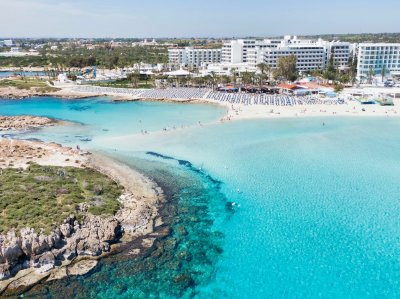Easter is the greatest holiday in the Cyprus Orthodox Church. It is fixed according to the moon - that is to say, it is always celebrated on the first Sunday following the full moon of the spring equinox. To celebrate Easter everything should look clean and new, so houses are cleaned, painted or white-washed, and new clothes are a "must", especially new shoes.
Holy Week is dedicated to church-going and to baking, etc.

At seaside places preparations for Palm Sunday can be seen from the previous Friday. In the coffee shops, fishermen sit and plait intricate "vaynes" ~ palm-leaf flower holders ~ which when finished, resemble little swallows' nests perched on sticks. The fishermen sell these and the young children fill them with flowers and take them to church on Palm Sunday when they follow the icon of Christ around the church in a procession commemorating Christ's entry into Jerusalem. The older boys hold large palm leaves.
Olive leaves are put into pillow-case-like sacks which are taken to church; there they are kept for forty days after which they can be used for incense burning.
From now on there are church services morning, afternoon and evening.

At seaside places preparations for Palm Sunday can be seen from the previous Friday.
In the coffee shops, fishermen sit and plait intricate "vaynes" ~ palm-leaf flower holders ~ which when finished, resemble little swallows' nests perched on sticks. The fishermen sell these and the young children fill them with flowers and take them to church on Palm Sunday
when they follow the icon of Christ around the church in a procession commemorating Christ's entry into Jerusalem. The older boys hold large palm leaves.
Olive leaves are put into pillow-case-like sacks which are taken to church; there they are kept for forty days after which they can be used for incense burning. From now on there are church services morning, afternoon and evening.

On Thursday most women do their Easter baking of "flaounes", a kind of cheese cake found in Cyprus, made of shortcrust with a cheese, egg and mint filling, formed into triangular and square shapes.
"Koulouria" are baked with milk, spices and a little sugar and "Tyropittes" ~ loaves with small pieces of cheese added and rolled in sesame seeds. Eggs are dyed as well. Traditionally they are dyed red with a special root called "rizari", that is sold in bundles at the market during these days. They are also dyed yellow; for this purpose the yellow marguerites that cover the waysides and fields during April are used.

However, in the towns you can buy small packets of different colored dyes from your grocer. Some dye their eggs in a more artistic way by tying the marguerites onto the eggs with a piece of muslin before boiling them in a color. The end product is most effective. Bread is also an important part of Easter celebration cooking and many different types of bread is made.

Good Friday begins with everyone taking flowers to church so that the young girls can decorate the "Epitafios" ~ Holy Sepulchre. At lunchtime the traditional "Faki Xidati" - vinegar and lentil soup - is eaten, containing vinegar because it is said that when Christ asked for water on his way to Calgary He was given vinegar instead.
From early afternoon you will see streams of cars and pedestrians going from church to church to pay their last respects to Christ - and to compare the decoration of their own parish "Epitafios" with that of the others.

In the meantime, all the streets along which the "Epitafios" will pass in the solemn procession later that night are being decorated with colored lights. The procession starts after the evening service with the priests preceding, then the Scouts or young men carrying the litter of Christ and then the choir, singing hymns. The whole congregation follows, and children light sparklers on the way. Fireworks are lit from the balconies while the procession moves around its parish boundaries and ends up at the church again.

Saturday is a quiet day, although there is a sermon towards lunchtime during which the church doors are banged and candleholders shaken, when the news is brought that Christ is no longer in His grave.
The real sermon of resurrection is at about midnight. Everybody goes to church with a candle and the sermon is held to the accompaniment of fire-crackers. A big bonfire is lit in the church yard. When the priest proclaims that "Christ has risen", all candles are lit and everyone greets everyone else with "Christos anesti" ~Christ has risen, to which the other answers "Alithos anesti" ~ Indeed He has risen.

On Sunday morning most people who have not taken Holy Communion during the Holy Week take it now and afterwards they go home, where red eggs are cracked, flaounes eaten and the fast broken. The children go around cracking and winning colored eggs, for if your egg cracks then you lose it and the child with the unbroken egg gets it. At lunchtime picnics and family gatherings are held everywhere; lamps are roasted on the spit and wine flows freely.

In the villages, Easter is an all-village affair apart from being a big holiday. On such days after Mass, the priest stands at the church door with the Cross and everyone leaving kisses the Cross, then shakes-and takes - the hand of the person in front, thus forming a large circle in the church yard which symbolizes the renewal of friendship with one another. After this, all friends and relations, but especially people from other towns or villages, are invited to the villagers' homes where they sit down together, eating and drinking until late in the afternoon.

In many villages it is also the custom on Easter Sunday and Monday for everyone to have lunch in the church yard and each family brings its food and wine and everybody eats at long tables made out of stands and long wooden planks. After lunch there are various games, dances and jokes. So all old quarrels are forgotten. The young people celebrate by hanging up "souses" - swings. For this purpose young men and girls hang ropes from trees and while the girls swing, they all sing happy songs or love songs, or teasing songs called "Tchatismata" - rhymes - These rhymes are made up at every festive occasion and there are even professionals who sing them. The characteristic of the "tchatismata" is that someone get up and starts by opening the subject in reciting praises for the host, something to tease a friend, or a love song for a girl. If he can, the one who has been made the subject of the thyme, gets up and replies by reciting his views on whatever has just been said.
More usually, however, there are two people singing the "tchatismata" by making up the rhyme as they go along, one making up the first few lines, the other the next few and so on.

Forty days after Easter, comes the Day of the Ascension which is considered such a great holiday that it is said that "even the swallows do not build their nests" on that day. It is a fasting day and one should not work at all, but spend the day praying and meditating. Incense should be burnt in the houses seven times.
Fifty days after Easter comes "Kataklysmos" - the Day of the Holy Ghost. In Cyprus it is celebrated by fairs held on the water fronts. This celebration is said to have descended to us from the feasts in honour of Aphrodite which were also held on the water fronts. To this day people go to pay homage to the "holy water fronts", where water sports are held and people go around in boats and even splash each other just for the fun of it.




